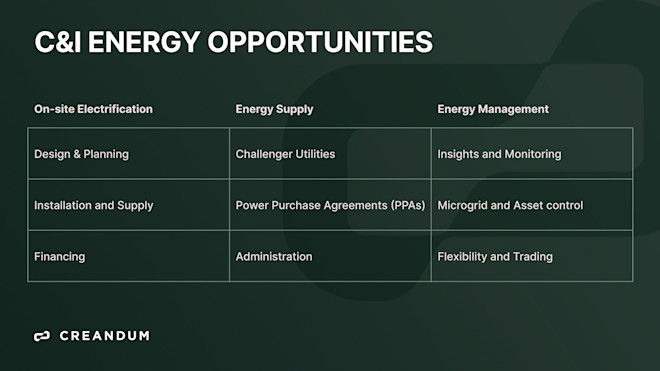Powering the future: Revolutionizing Commercial & Industrial Energy

While most of the attention in the climate tech movement has focused on consumer energy such as electric vehicles and residential solar power, the Commercial & Industrial (C&I) sector quietly plays a significant role in shaping Europe’s energy landscape. The sector accounts for approximately 40% of Europe’s energy usage and therefore a significant share of emissions given Europe’s continued reliance on fossil fuels.
The business energy problem must be addressed if we are to get even close to net zero goals. The good news is that more and more businesses are proactively seeking ways to cut their reliance on fossil fuels. Energy price shocks and volatility in recent years, driven by geopolitical events, is certainly a big contributing factor, putting energy procurement high-up the agenda. Other driving factors include increasing green regulations and customer expectations and pressure to reduce emissions.
However, despite this growing demand for products and services to support the switch to renewable energy, the C&I sector is to date largely underserved, creating a massive opportunity for disruption and innovation.

What is C&I Energy?
Why is the market underserved?
Mid sized businesses are too diverse and their energy consumption too small to attract high quality, tailored energy services from incumbent energy providers. Unlike large enterprises, who can negotiate favorable energy procurement portfolios, smaller businesses are often locked into inflexible contracts or exposed to volatile market prices.
Lack of in-house energy expertise: this is not a core competency for small business owners nor an added headcount cost they can take on.
Lack of information: businesses often lack real time data on energy consumption and transparency around pricing from their energy suppliers.
Complexity of becoming prosumers: As businesses transition from energy consumers to generating their own energy on-site through systems like rooftop solar, they find themselves struggling to integrate these assets in their overall energy mix and balancing self-generated energy with market supply.

C&I Energy Opportunity Areas
On-site electrification
As in the consumer residential space, businesses are shifting towards on-site renewable energy generation to reduce their reliance on volatile fossil fuels. This includes installing rooftop PV, switching out gas-powered heating systems for heat pumps, adding battery capacity and facilitating EV-charging infrastructure.
This creates opportunities across this entire value chain:
Design and Planning: Effective on-site electrification starts with meticulous system planning and design. Companies like Reonic and Autarc develop tools that can accurately and quickly perform on-site electrification simulations, generating rapid quotes for different system installations and cost profiles.
Installation and Supply: Once planned, these complex energy systems need to be installed. Startups like Inrange, and Metris Energy offer full-stack solutions, managing everything from initial design to the final installation. This reduces the complexity for C&I businesses, allowing them to focus on their core operations while experts handle the technical aspects.
Financing: The upfront cost of on-site electrification can be a significant barrier for C&I businesses. Startups offer innovative, integrated and customizable financing solutions such as leasing and as-a-service models aiming to mitigate the investment required and accompanying operational risk. Enviria, for instance, offers end-to-end electrification solutions with a variety of financing options and Alight Energy develops on-site and off-site solar projects and offers this back as Power Purchase Agreements (PPAs).
Energy supply
The lack of flexibility offered by energy incumbents to small businesses is opening the door to new challenger utilities, launching packages customized to the specific consumption needs of C&I businesses.
Challenger Utilities: Tailored packages include blends of on-site and off-site energy, combining renewable energy sources like solar and wind with dynamic market-driven contracts, helping businesses reduce costs as well as increase cost predictability. Examples include: Trawa, Frequenz (Neustrom), and Tem Energy. Each of these players has its own approach to energy supply, but all share a common goal: tailored and competitively priced energy.
Power Purchase Agreements (PPAs): are long-term contracts where businesses agree to purchase energy directly from an electricity generator at a certain price. PPAs are complex to manage and are typically too large for a single small business to procure. Companies like LevelTen and Reel provide critical infrastructure to simplify the PPA process and democratize access to renewable energy and better prices.
Administration: Modern energy supply comes with its share of administrative challenges. Companies like Granular Energy and Flexidao offer robust tracking and certification systems for green energy, while Solarize and Einhundert streamline billing processes for multi-tenant properties using solar energy.
Energy management and connectivity
As businesses electrify and diversify their energy supply, managing this intricate web of systems and acting on the right insights becomes essential. Energy Management Systems (EMS) are at the heart of this, allowing businesses to monitor, optimize, and control their energy consumption in real time.
Insights and monitoring : One of the most critical functions of an EMS is to provide detailed insights into energy consumption and pricing. Traditional energy suppliers provide limited price transparency, leaving businesses with little understanding and predictability of the actual cost implications of their consumption. Companies like Companion Energy and Ecoplanet provide software to forecast and monitor energy costs, emissions and potential price risks.
Microgrid and asset control: Microgrids refer to local, intelligent electricity grids that combine power generation from renewable sources such as PV and storage systems in the local network. Whilst the concept isn’t new, the term has gained recent momentum as businesses move from being consumers to prosumers. Startups like Frequenz and Encentive enable C&I businesses to balance their energy needs between on-site generation (like PV) and the public grid, optimizing for both cost and sustainability.
Flexibility and trading: This allows businesses to adjust their energy consumption or trade energy back to the market in response to market signals, pricing fluctuations, or operational needs. While widespread adoption of these practices is still in the early stages, they offer significant potential benefits for demand response, energy shifting and load management. Many of the aforementioned players offer flexibility solutions. In addition, Dexter Energy offers forecasting and trade optimization software for C&I, Fever Energy allows companies to run virtual power plants and Cactos creates behind-the-meter energy storage systems and optimizes these as part of the energy-mix.
Factors for success
There is undoubtedly a massive opportunity here. But as with all such opportunities, the market is moving quickly and becoming increasingly crowded with new players. As we evaluate companies in this space, we are looking for a number of factors that we believe will mark out the winners:
Holistic solutions are the future
Businesses increasingly want to address their energy needs in a comprehensive, interconnected manner. Rather than focusing on isolated measures like solar and EV-charger installation systems in silos, businesses are looking for seamless integration of electrification, energy supply, storage, and real-time management.
Convergence is inevitable
While many startups begin by offering point solutions, the market will start to converge as it matures. In part due to the inherently interlinked challenges most startups solve (as per above) and customer demand for a simplified setup. Businesses no longer want to manage a patchwork of suppliers and technologies; they need a one-stop solution or nimble set-up that simplifies the complexity of their energy needs.
Companies that can crack the best entry-point to offer a full-suite of integrated energy solutions will be in a position to extract most value from the ecosystem.
Customization is key while limiting complexity
The energy needs of C&I customers are highly diverse. Companies that can provide tailored solutions, whether it’s customized energy contracts or bespoke electrification plans - will succeed. The challenge lies in balancing this customization with scalability, ensuring that businesses can adapt their product to meet their specific requirements while not getting lost in operational complexity.
Winners will scale across borders
Energy markets in Europe are largely national; each with its own market dynamics and local players. Startups aiming to build large businesses must realize that success at home is just the first step; scaling across multiple markets is key to becoming a billion-dollar company.
The ability to navigate varying regulatory frameworks and market conditions will separate local champions from the next-generation global energy players. Startups that can successfully expand beyond their home market will unlock exponential growth potential and solidify their position in the evolving energy landscape.
Stellar teams and execution will define the winners:
As the opportunity in the C&I energy landscape unfolds itself, timing and flawless execution are everything. First movers will benefit less from network effects alone, but more from flawless execution.
Startups that can quickly gain the trust of risk-averse C&I customers and scale their operations efficiently will be in a prime position to dominate the market.
This is a once-in-a-generation land grab opportunity—those who can execute well will secure early market share, drive down costs through economies of scale, and establish themselves as the go-to providers.
Software v operations
While venture capitalists are often biased towards software-only businesses, startups that aren’t afraid to tackle complex operational challenges at scale hold enormous potential. The combination of strong teams, sound execution, and the willingness to solve operational issues will separate the true market leaders from the rest.
Conclusion
The seeds of this massive opportunity in C&I energy have been in place for a while - the global drive towards net zero, the falling price of renewables, regulation, and the lack of innovation from energy incumbents. As the market continues to evolve rapidly, what works today could be outdated tomorrow. The most successful companies will be those that can adapt quickly, embrace change, and continuously innovate to stay ahead of the curve.
We have no doubt that big, global winners will emerge to serve the C&I energy market and we are very excited to meet and back these winners. If you're building solutions in electrification, energy supply, or energy management we’d love to hear from you!